Leadership and Change Management: Barriers and Approaches
VerifiedAdded on 2022/12/09
|15
|1675
|181
Presentation
AI Summary
This presentation delves into the critical aspects of leadership and change management, focusing on how leaders navigate organizational transformations. The content begins by identifying various barriers to change and analyzing their impact on leadership decision-making, using EasyJet Plc as a case study. It then explores the application of Force Field Analysis to evaluate driving and resisting forces, demonstrating how this tool influences decision-making processes. Furthermore, the presentation examines different leadership approaches, including traits, functional, relational, transformational, and situational approaches, as well as models like Hersey and Blanchard's Situational Leadership and Kotter's 8-step model, to deliver organizational change. The effectiveness of these approaches and models are evaluated, providing a comprehensive understanding of how leaders can successfully manage and implement change within organizations. The presentation concludes by summarizing key findings and insights regarding change management in leadership, and providing references for further study.

Leadership and
Change Management
Change Management
Paraphrase This Document
Need a fresh take? Get an instant paraphrase of this document with our AI Paraphraser
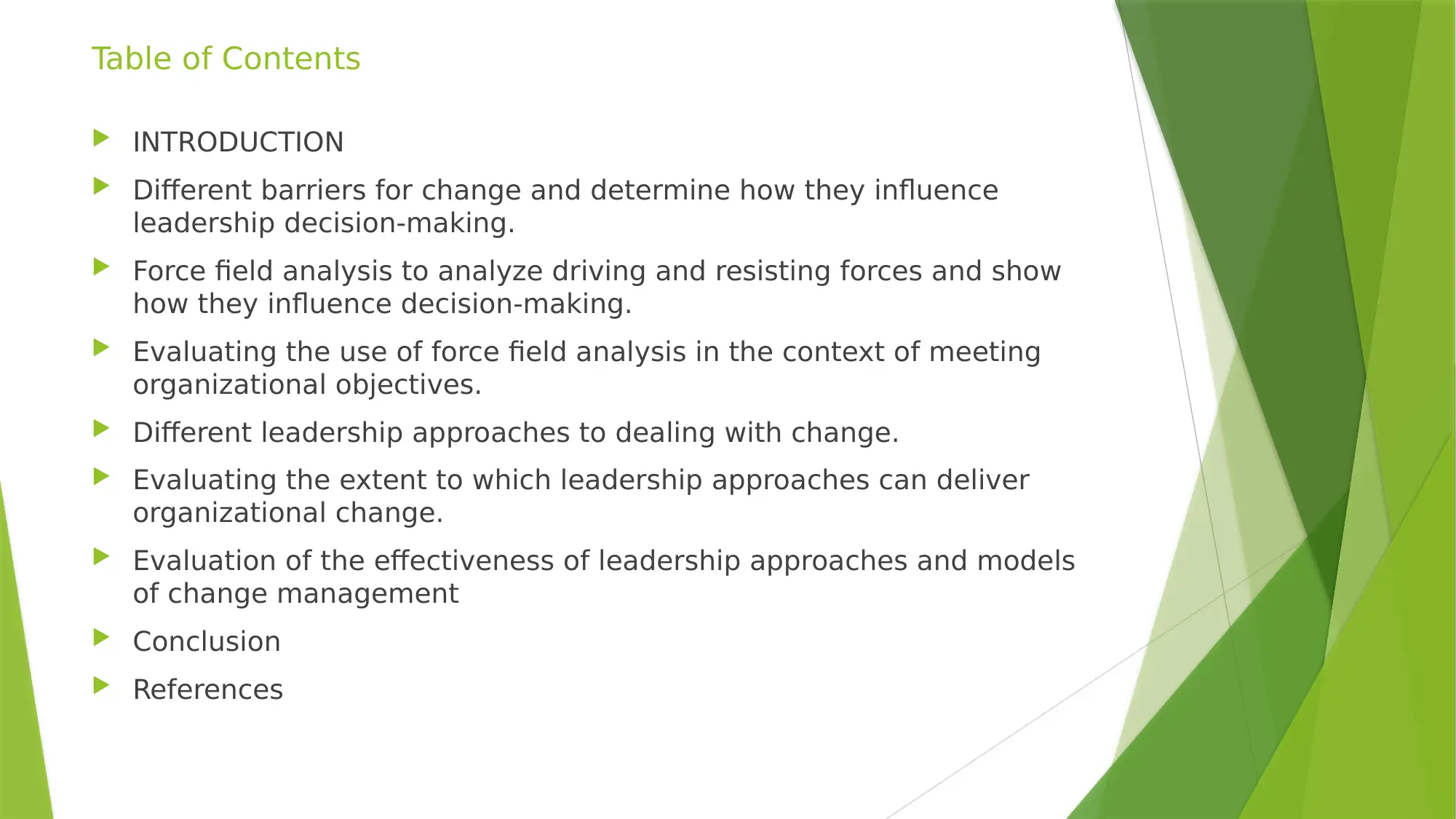
Table of Contents
INTRODUCTION
Different barriers for change and determine how they influence
leadership decision-making.
Force field analysis to analyze driving and resisting forces and show
how they influence decision-making.
Evaluating the use of force field analysis in the context of meeting
organizational objectives.
Different leadership approaches to dealing with change.
Evaluating the extent to which leadership approaches can deliver
organizational change.
Evaluation of the effectiveness of leadership approaches and models
of change management
Conclusion
References
INTRODUCTION
Different barriers for change and determine how they influence
leadership decision-making.
Force field analysis to analyze driving and resisting forces and show
how they influence decision-making.
Evaluating the use of force field analysis in the context of meeting
organizational objectives.
Different leadership approaches to dealing with change.
Evaluating the extent to which leadership approaches can deliver
organizational change.
Evaluation of the effectiveness of leadership approaches and models
of change management
Conclusion
References
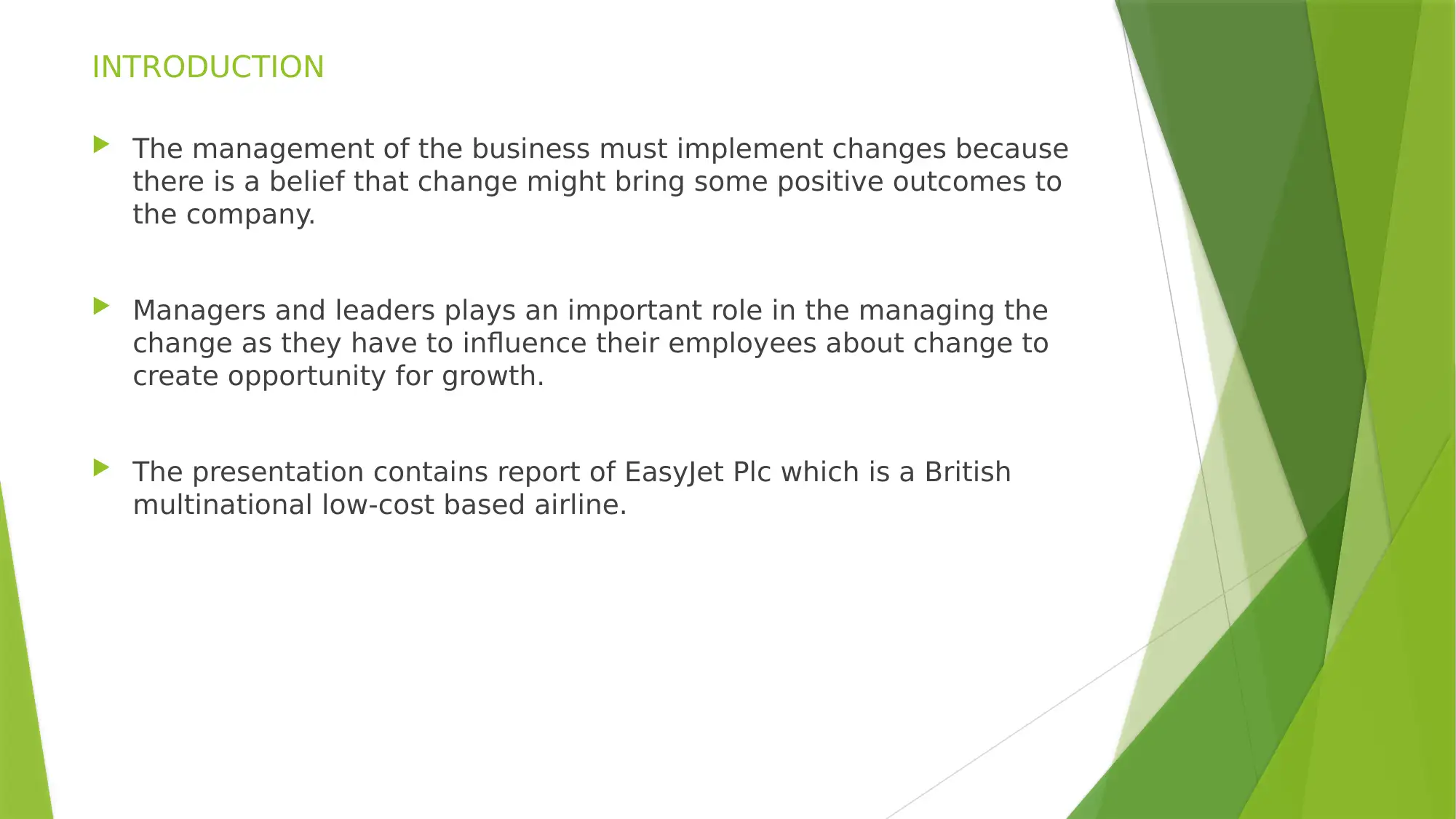
INTRODUCTION
The management of the business must implement changes because
there is a belief that change might bring some positive outcomes to
the company.
Managers and leaders plays an important role in the managing the
change as they have to influence their employees about change to
create opportunity for growth.
The presentation contains report of EasyJet Plc which is a British
multinational low-cost based airline.
The management of the business must implement changes because
there is a belief that change might bring some positive outcomes to
the company.
Managers and leaders plays an important role in the managing the
change as they have to influence their employees about change to
create opportunity for growth.
The presentation contains report of EasyJet Plc which is a British
multinational low-cost based airline.
⊘ This is a preview!⊘
Do you want full access?
Subscribe today to unlock all pages.

Trusted by 1+ million students worldwide
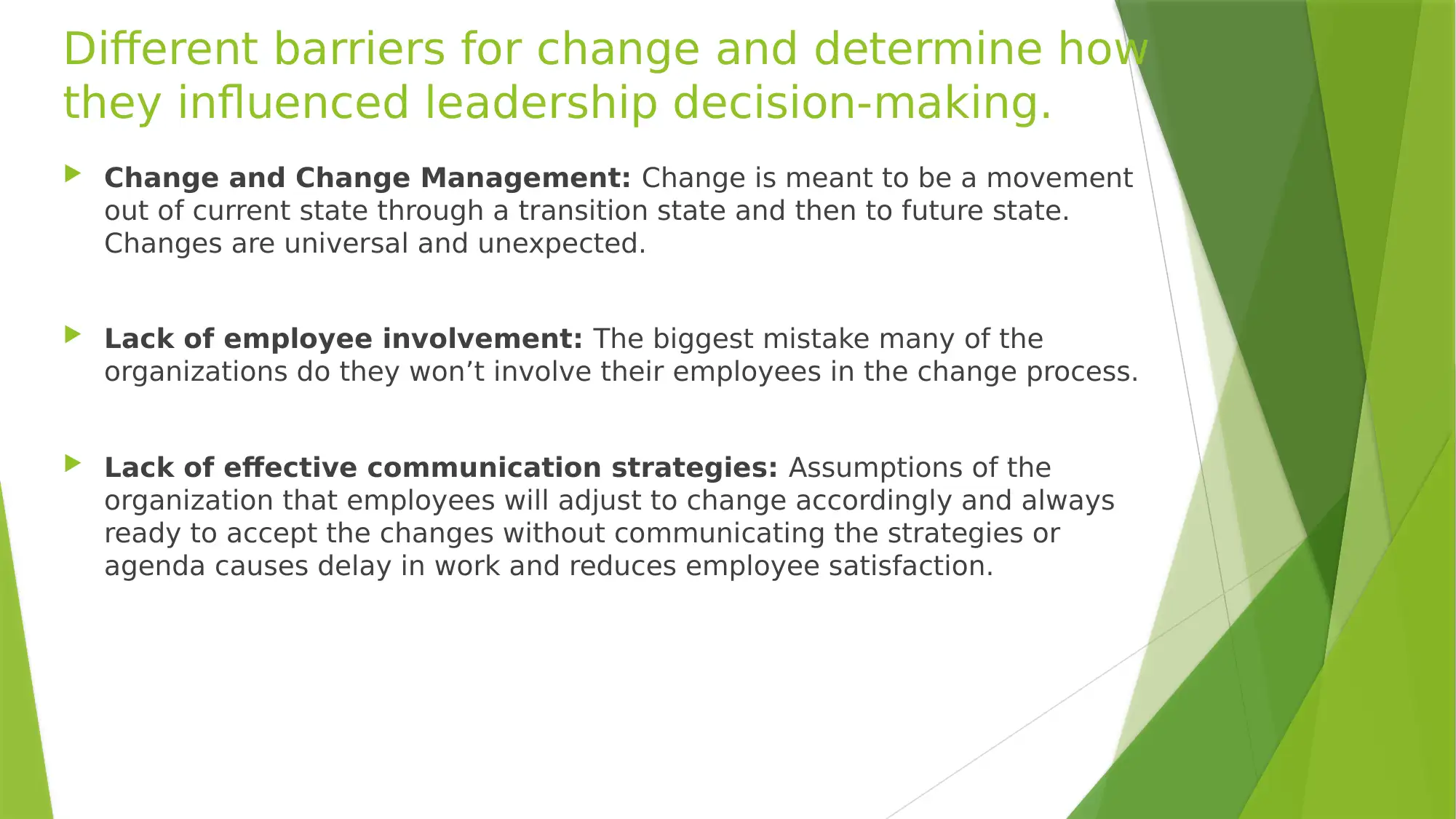
Different barriers for change and determine how
they influenced leadership decision-making.
Change and Change Management: Change is meant to be a movement
out of current state through a transition state and then to future state.
Changes are universal and unexpected.
Lack of employee involvement: The biggest mistake many of the
organizations do they won’t involve their employees in the change process.
Lack of effective communication strategies: Assumptions of the
organization that employees will adjust to change accordingly and always
ready to accept the changes without communicating the strategies or
agenda causes delay in work and reduces employee satisfaction.
they influenced leadership decision-making.
Change and Change Management: Change is meant to be a movement
out of current state through a transition state and then to future state.
Changes are universal and unexpected.
Lack of employee involvement: The biggest mistake many of the
organizations do they won’t involve their employees in the change process.
Lack of effective communication strategies: Assumptions of the
organization that employees will adjust to change accordingly and always
ready to accept the changes without communicating the strategies or
agenda causes delay in work and reduces employee satisfaction.
Paraphrase This Document
Need a fresh take? Get an instant paraphrase of this document with our AI Paraphraser
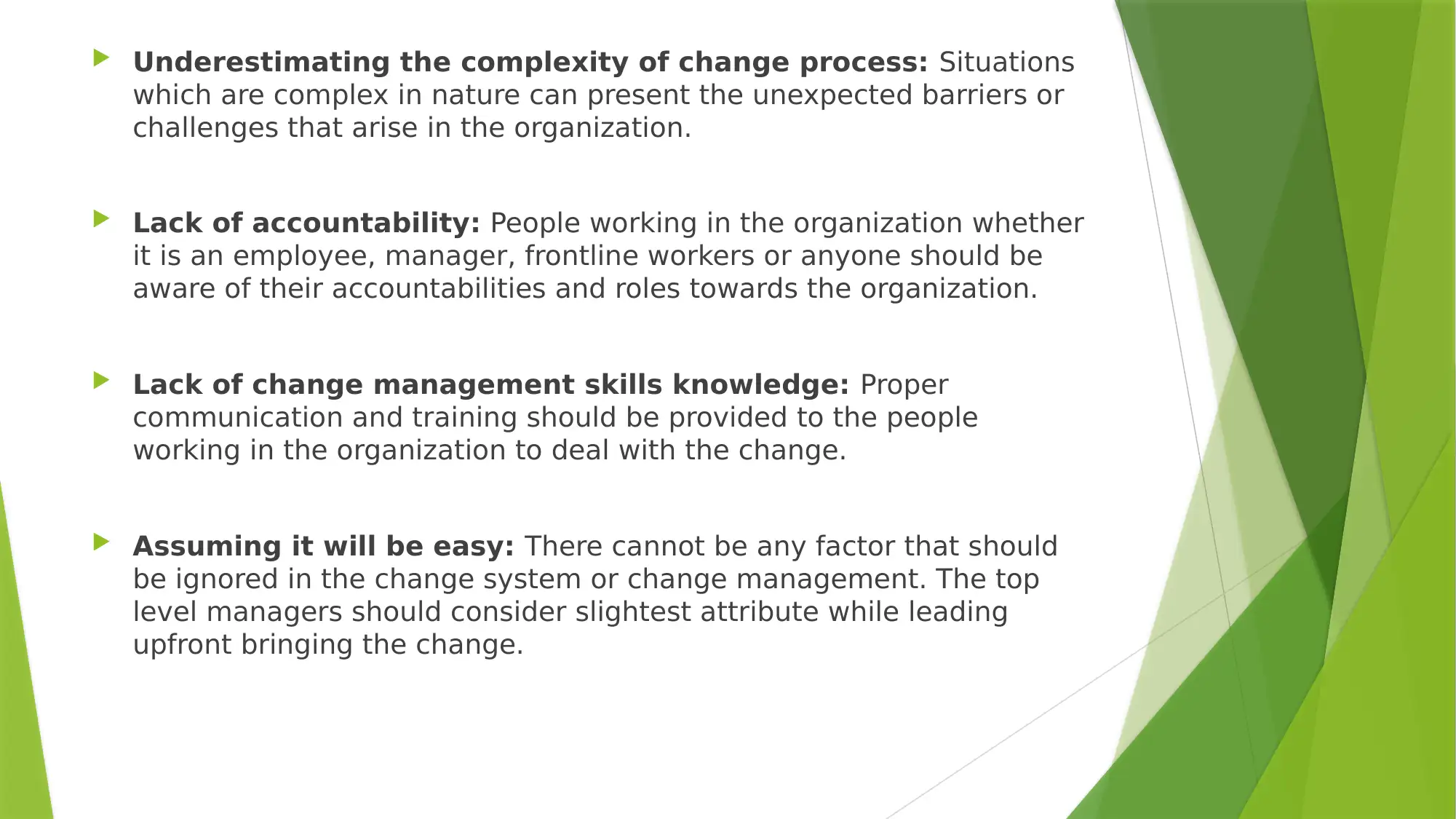
Underestimating the complexity of change process: Situations
which are complex in nature can present the unexpected barriers or
challenges that arise in the organization.
Lack of accountability: People working in the organization whether
it is an employee, manager, frontline workers or anyone should be
aware of their accountabilities and roles towards the organization.
Lack of change management skills knowledge: Proper
communication and training should be provided to the people
working in the organization to deal with the change.
Assuming it will be easy: There cannot be any factor that should
be ignored in the change system or change management. The top
level managers should consider slightest attribute while leading
upfront bringing the change.
which are complex in nature can present the unexpected barriers or
challenges that arise in the organization.
Lack of accountability: People working in the organization whether
it is an employee, manager, frontline workers or anyone should be
aware of their accountabilities and roles towards the organization.
Lack of change management skills knowledge: Proper
communication and training should be provided to the people
working in the organization to deal with the change.
Assuming it will be easy: There cannot be any factor that should
be ignored in the change system or change management. The top
level managers should consider slightest attribute while leading
upfront bringing the change.
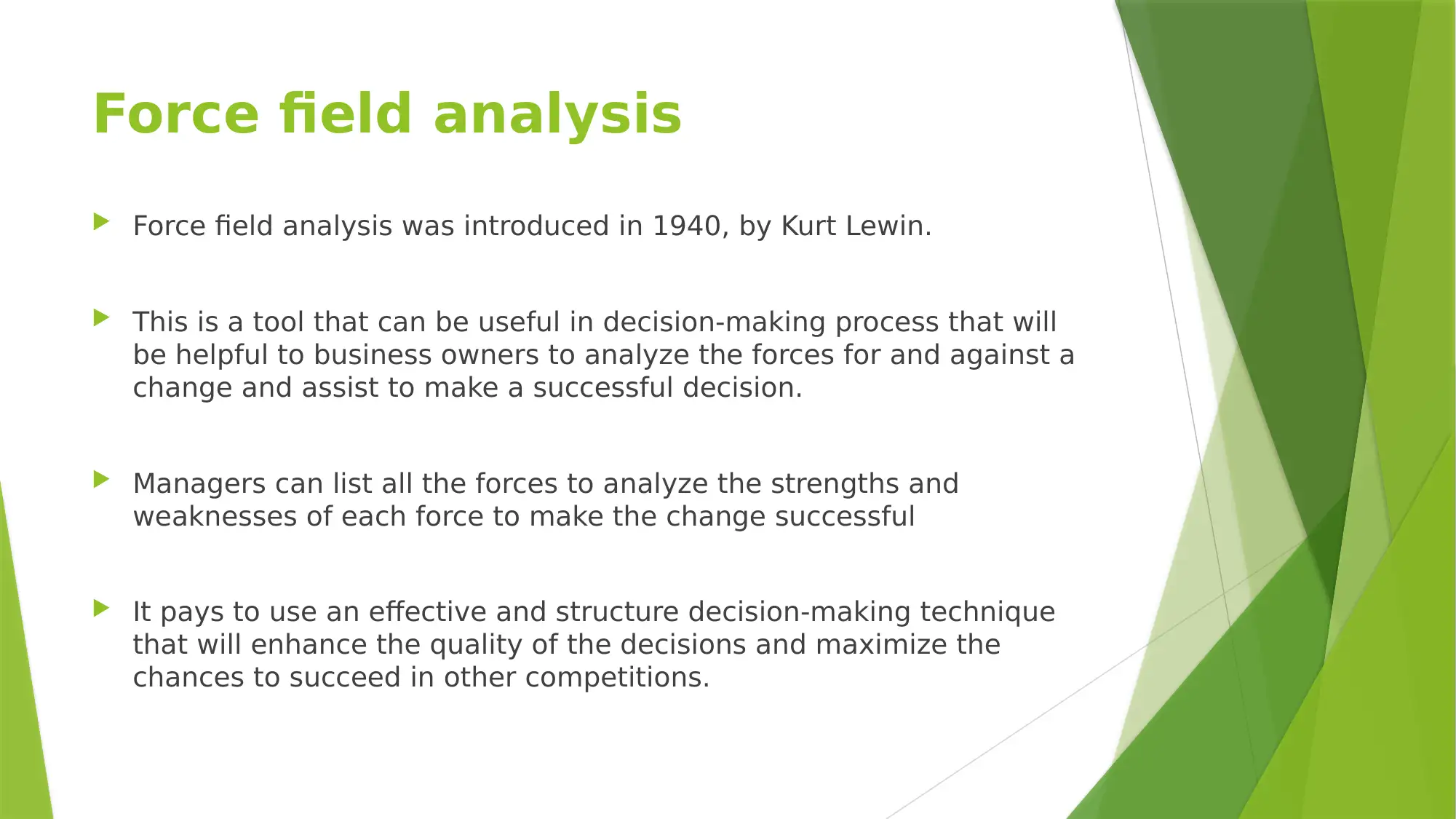
Force field analysis
Force field analysis was introduced in 1940, by Kurt Lewin.
This is a tool that can be useful in decision-making process that will
be helpful to business owners to analyze the forces for and against a
change and assist to make a successful decision.
Managers can list all the forces to analyze the strengths and
weaknesses of each force to make the change successful
It pays to use an effective and structure decision-making technique
that will enhance the quality of the decisions and maximize the
chances to succeed in other competitions.
Force field analysis was introduced in 1940, by Kurt Lewin.
This is a tool that can be useful in decision-making process that will
be helpful to business owners to analyze the forces for and against a
change and assist to make a successful decision.
Managers can list all the forces to analyze the strengths and
weaknesses of each force to make the change successful
It pays to use an effective and structure decision-making technique
that will enhance the quality of the decisions and maximize the
chances to succeed in other competitions.
⊘ This is a preview!⊘
Do you want full access?
Subscribe today to unlock all pages.

Trusted by 1+ million students worldwide
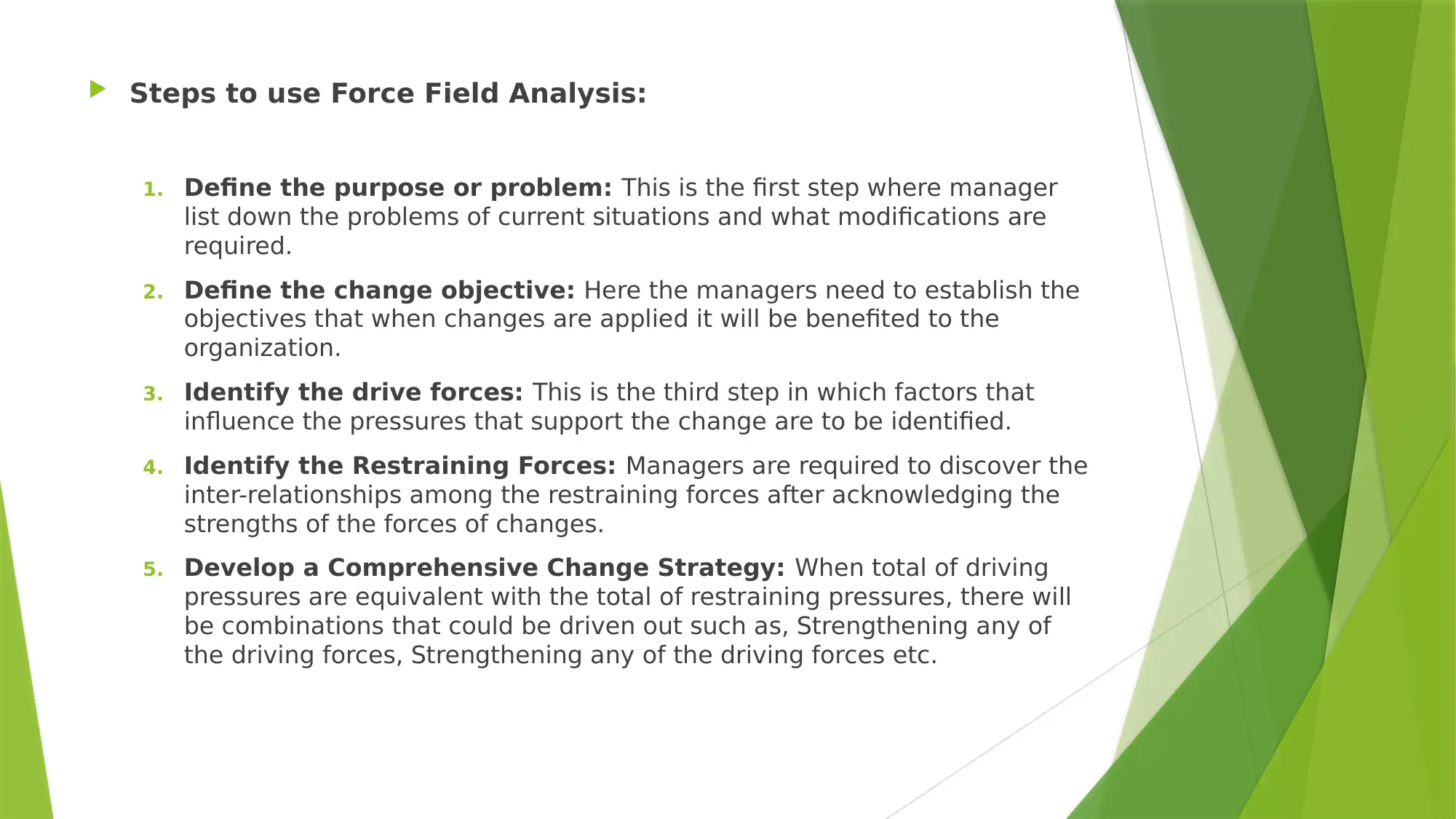
Steps to use Force Field Analysis:
1. Define the purpose or problem: This is the first step where manager
list down the problems of current situations and what modifications are
required.
2. Define the change objective: Here the managers need to establish the
objectives that when changes are applied it will be benefited to the
organization.
3. Identify the drive forces: This is the third step in which factors that
influence the pressures that support the change are to be identified.
4. Identify the Restraining Forces: Managers are required to discover the
inter-relationships among the restraining forces after acknowledging the
strengths of the forces of changes.
5. Develop a Comprehensive Change Strategy: When total of driving
pressures are equivalent with the total of restraining pressures, there will
be combinations that could be driven out such as, Strengthening any of
the driving forces, Strengthening any of the driving forces etc.
1. Define the purpose or problem: This is the first step where manager
list down the problems of current situations and what modifications are
required.
2. Define the change objective: Here the managers need to establish the
objectives that when changes are applied it will be benefited to the
organization.
3. Identify the drive forces: This is the third step in which factors that
influence the pressures that support the change are to be identified.
4. Identify the Restraining Forces: Managers are required to discover the
inter-relationships among the restraining forces after acknowledging the
strengths of the forces of changes.
5. Develop a Comprehensive Change Strategy: When total of driving
pressures are equivalent with the total of restraining pressures, there will
be combinations that could be driven out such as, Strengthening any of
the driving forces, Strengthening any of the driving forces etc.
Paraphrase This Document
Need a fresh take? Get an instant paraphrase of this document with our AI Paraphraser
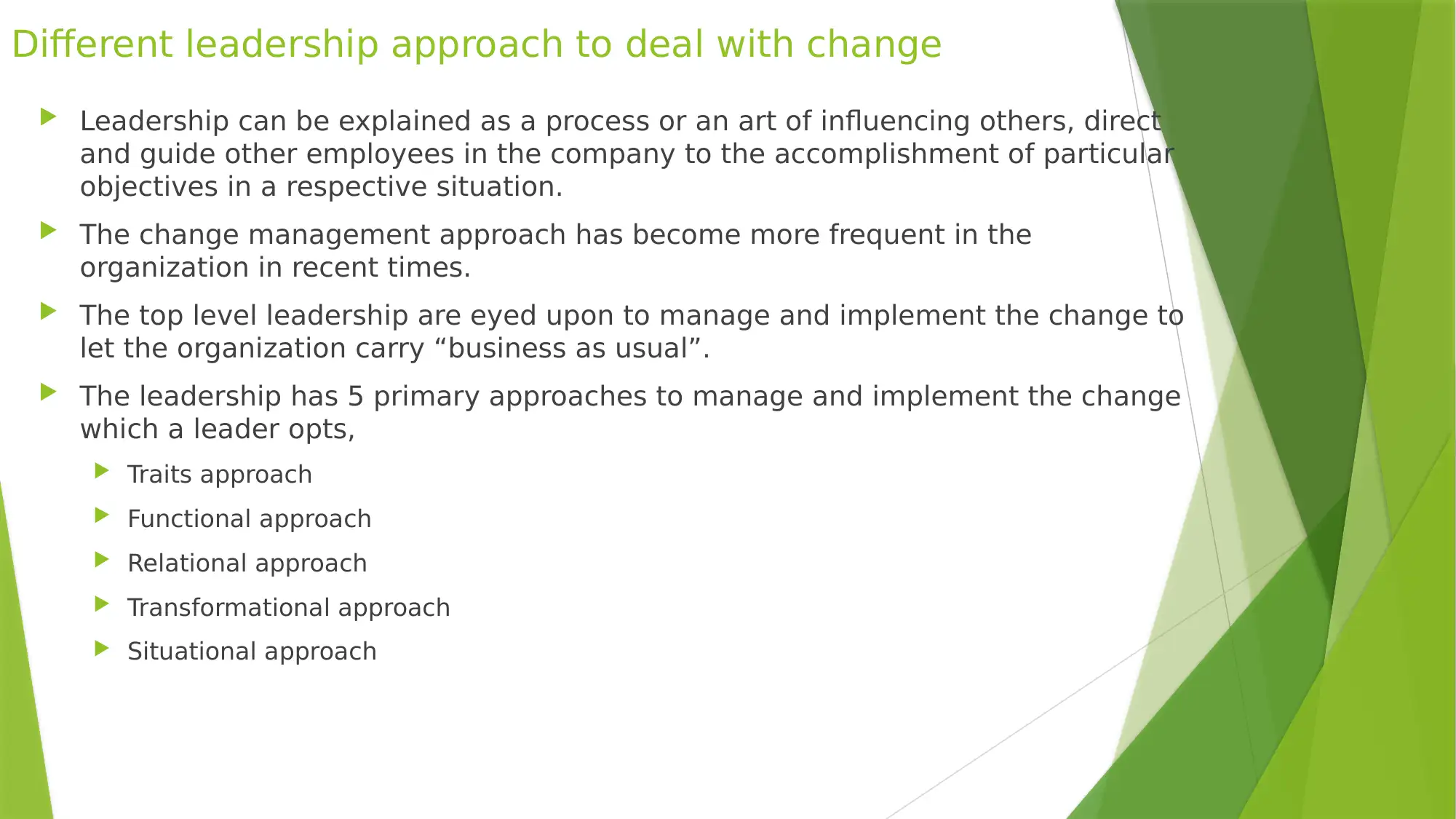
Different leadership approach to deal with change
Leadership can be explained as a process or an art of influencing others, direct
and guide other employees in the company to the accomplishment of particular
objectives in a respective situation.
The change management approach has become more frequent in the
organization in recent times.
The top level leadership are eyed upon to manage and implement the change to
let the organization carry “business as usual”.
The leadership has 5 primary approaches to manage and implement the change
which a leader opts,
Traits approach
Functional approach
Relational approach
Transformational approach
Situational approach
Leadership can be explained as a process or an art of influencing others, direct
and guide other employees in the company to the accomplishment of particular
objectives in a respective situation.
The change management approach has become more frequent in the
organization in recent times.
The top level leadership are eyed upon to manage and implement the change to
let the organization carry “business as usual”.
The leadership has 5 primary approaches to manage and implement the change
which a leader opts,
Traits approach
Functional approach
Relational approach
Transformational approach
Situational approach
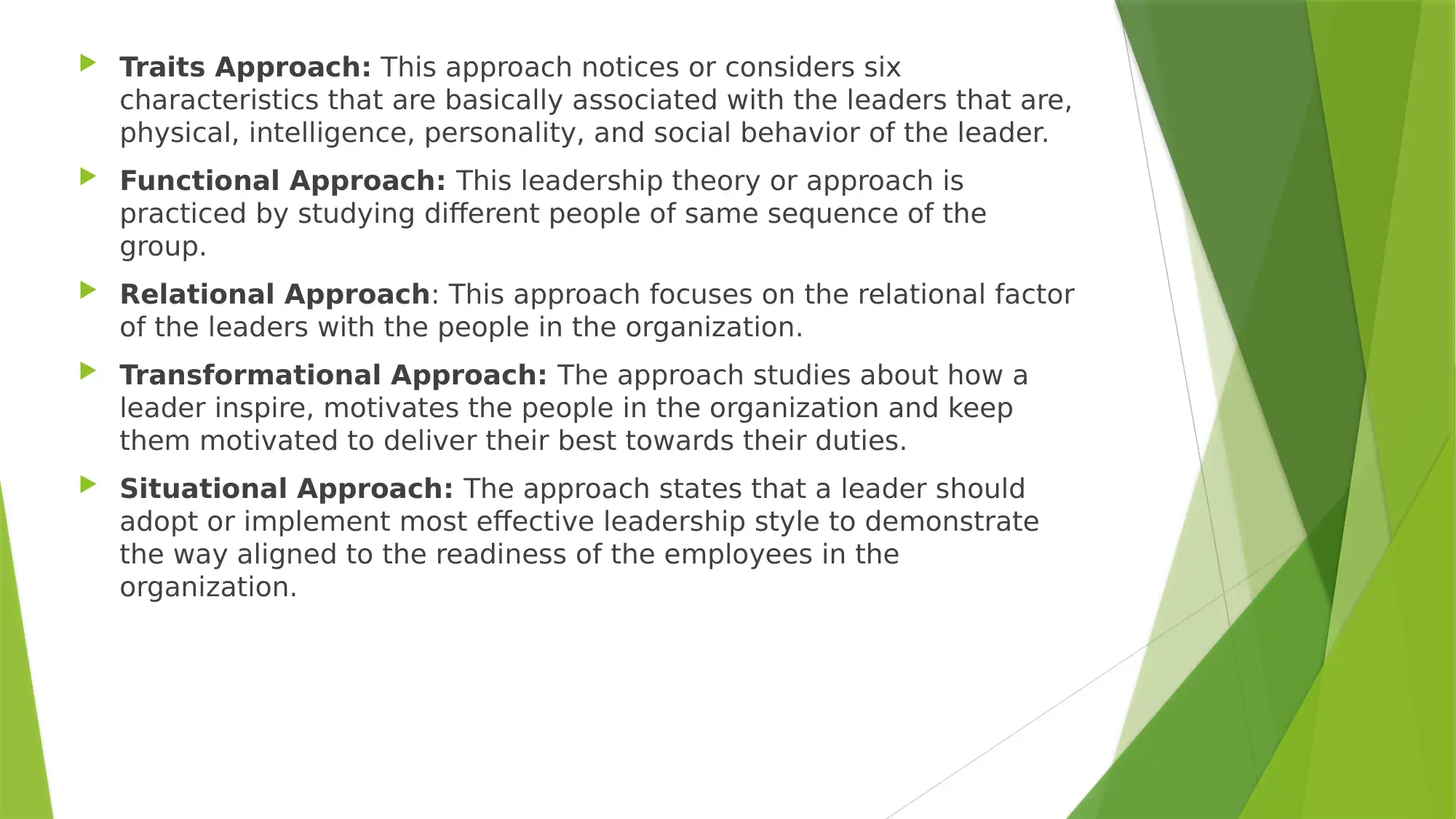
Traits Approach: This approach notices or considers six
characteristics that are basically associated with the leaders that are,
physical, intelligence, personality, and social behavior of the leader.
Functional Approach: This leadership theory or approach is
practiced by studying different people of same sequence of the
group.
Relational Approach: This approach focuses on the relational factor
of the leaders with the people in the organization.
Transformational Approach: The approach studies about how a
leader inspire, motivates the people in the organization and keep
them motivated to deliver their best towards their duties.
Situational Approach: The approach states that a leader should
adopt or implement most effective leadership style to demonstrate
the way aligned to the readiness of the employees in the
organization.
characteristics that are basically associated with the leaders that are,
physical, intelligence, personality, and social behavior of the leader.
Functional Approach: This leadership theory or approach is
practiced by studying different people of same sequence of the
group.
Relational Approach: This approach focuses on the relational factor
of the leaders with the people in the organization.
Transformational Approach: The approach studies about how a
leader inspire, motivates the people in the organization and keep
them motivated to deliver their best towards their duties.
Situational Approach: The approach states that a leader should
adopt or implement most effective leadership style to demonstrate
the way aligned to the readiness of the employees in the
organization.
⊘ This is a preview!⊘
Do you want full access?
Subscribe today to unlock all pages.

Trusted by 1+ million students worldwide
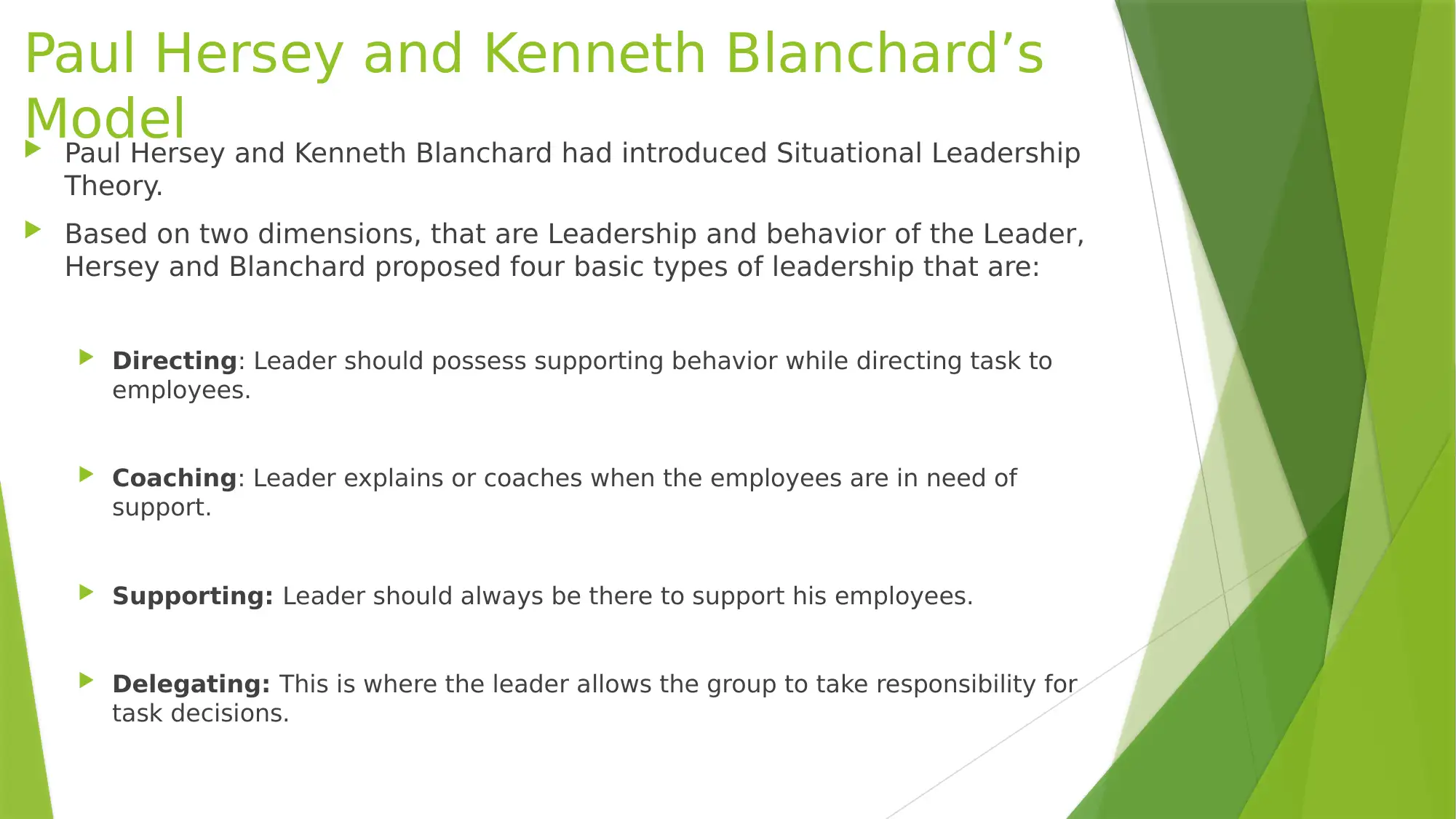
Paul Hersey and Kenneth Blanchard’s
Model Paul Hersey and Kenneth Blanchard had introduced Situational Leadership
Theory.
Based on two dimensions, that are Leadership and behavior of the Leader,
Hersey and Blanchard proposed four basic types of leadership that are:
Directing: Leader should possess supporting behavior while directing task to
employees.
Coaching: Leader explains or coaches when the employees are in need of
support.
Supporting: Leader should always be there to support his employees.
Delegating: This is where the leader allows the group to take responsibility for
task decisions.
Model Paul Hersey and Kenneth Blanchard had introduced Situational Leadership
Theory.
Based on two dimensions, that are Leadership and behavior of the Leader,
Hersey and Blanchard proposed four basic types of leadership that are:
Directing: Leader should possess supporting behavior while directing task to
employees.
Coaching: Leader explains or coaches when the employees are in need of
support.
Supporting: Leader should always be there to support his employees.
Delegating: This is where the leader allows the group to take responsibility for
task decisions.
Paraphrase This Document
Need a fresh take? Get an instant paraphrase of this document with our AI Paraphraser
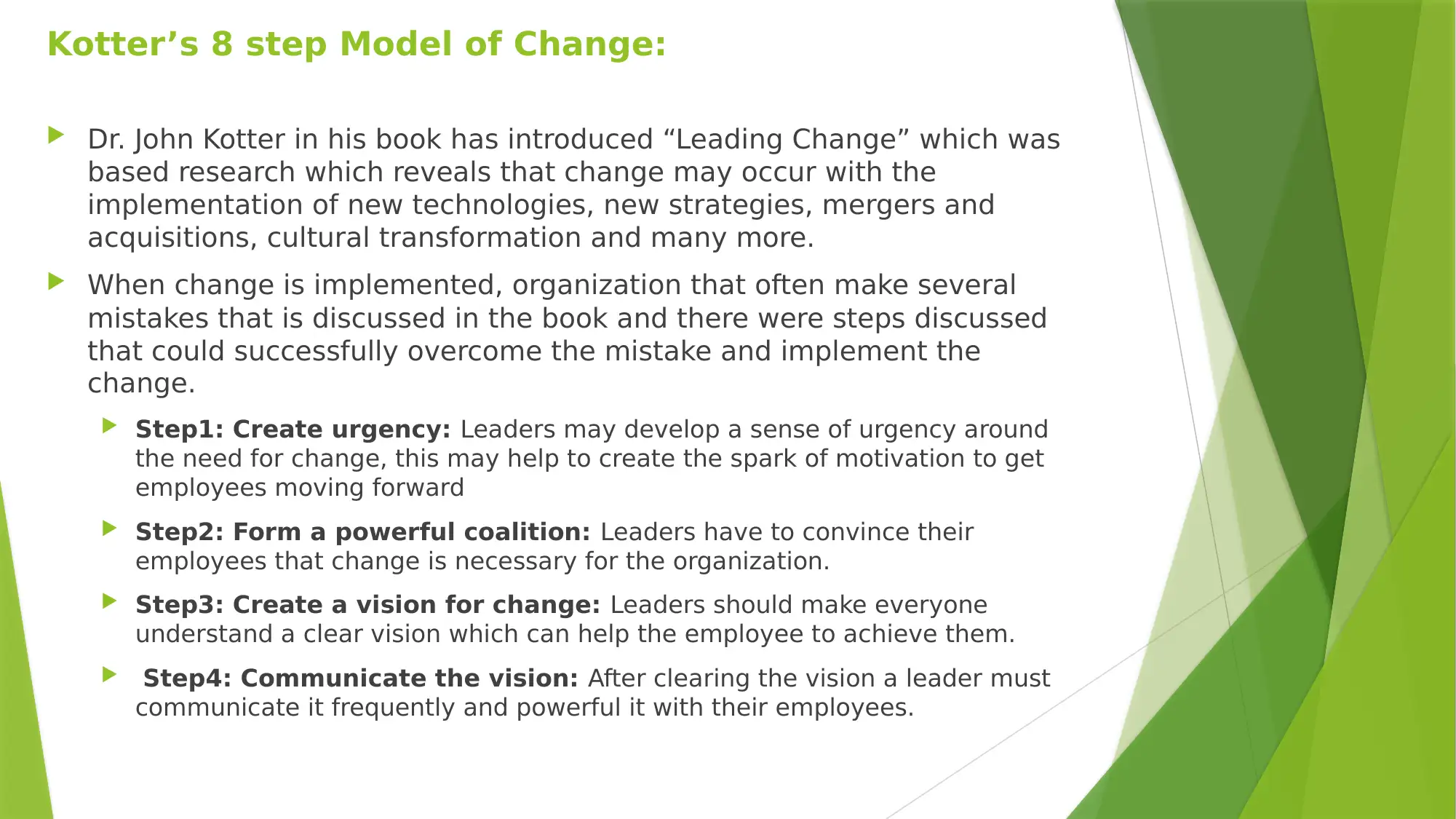
Kotter’s 8 step Model of Change:
Dr. John Kotter in his book has introduced “Leading Change” which was
based research which reveals that change may occur with the
implementation of new technologies, new strategies, mergers and
acquisitions, cultural transformation and many more.
When change is implemented, organization that often make several
mistakes that is discussed in the book and there were steps discussed
that could successfully overcome the mistake and implement the
change.
Step1: Create urgency: Leaders may develop a sense of urgency around
the need for change, this may help to create the spark of motivation to get
employees moving forward
Step2: Form a powerful coalition: Leaders have to convince their
employees that change is necessary for the organization.
Step3: Create a vision for change: Leaders should make everyone
understand a clear vision which can help the employee to achieve them.
Step4: Communicate the vision: After clearing the vision a leader must
communicate it frequently and powerful it with their employees.
Dr. John Kotter in his book has introduced “Leading Change” which was
based research which reveals that change may occur with the
implementation of new technologies, new strategies, mergers and
acquisitions, cultural transformation and many more.
When change is implemented, organization that often make several
mistakes that is discussed in the book and there were steps discussed
that could successfully overcome the mistake and implement the
change.
Step1: Create urgency: Leaders may develop a sense of urgency around
the need for change, this may help to create the spark of motivation to get
employees moving forward
Step2: Form a powerful coalition: Leaders have to convince their
employees that change is necessary for the organization.
Step3: Create a vision for change: Leaders should make everyone
understand a clear vision which can help the employee to achieve them.
Step4: Communicate the vision: After clearing the vision a leader must
communicate it frequently and powerful it with their employees.
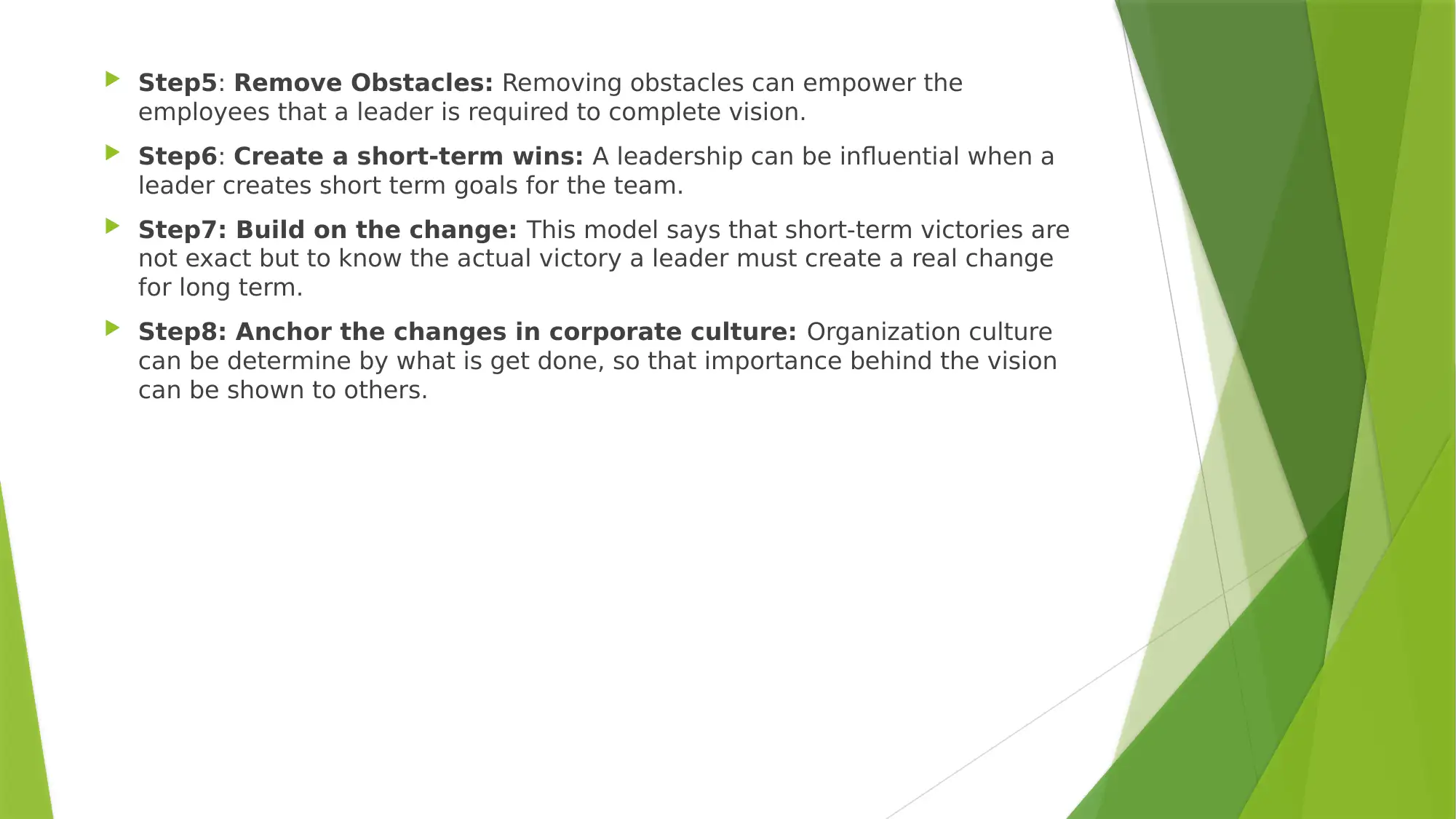
Step5: Remove Obstacles: Removing obstacles can empower the
employees that a leader is required to complete vision.
Step6: Create a short-term wins: A leadership can be influential when a
leader creates short term goals for the team.
Step7: Build on the change: This model says that short-term victories are
not exact but to know the actual victory a leader must create a real change
for long term.
Step8: Anchor the changes in corporate culture: Organization culture
can be determine by what is get done, so that importance behind the vision
can be shown to others.
employees that a leader is required to complete vision.
Step6: Create a short-term wins: A leadership can be influential when a
leader creates short term goals for the team.
Step7: Build on the change: This model says that short-term victories are
not exact but to know the actual victory a leader must create a real change
for long term.
Step8: Anchor the changes in corporate culture: Organization culture
can be determine by what is get done, so that importance behind the vision
can be shown to others.
⊘ This is a preview!⊘
Do you want full access?
Subscribe today to unlock all pages.

Trusted by 1+ million students worldwide
1 out of 15
Related Documents
Your All-in-One AI-Powered Toolkit for Academic Success.
+13062052269
info@desklib.com
Available 24*7 on WhatsApp / Email
![[object Object]](/_next/static/media/star-bottom.7253800d.svg)
Unlock your academic potential
Copyright © 2020–2025 A2Z Services. All Rights Reserved. Developed and managed by ZUCOL.


